Long-Term Evolution of the Climatic Factors and Its Influence on Grape Quality in Northeastern Romania
Abstract
:1. Introduction
2. Materials and Methods
2.1. Climate Data Collection
2.2. Studied Parameters and Bioclimatic Indices
2.3. Grapevine Cultivars and Growing Conditions
2.4. Chemical Determinations
2.5. Statistical Procedures
3. Results and Discussion
3.1. Climatic Elements
3.2. Bioclimatic Indices
3.3. Changes in Harvest Date
3.4. Changes in Grape Chemical Composition
4. Conclusions
Author Contributions
Funding
Data Availability Statement
Acknowledgments
Conflicts of Interest
References
- OIV (International Organization of Vine and Wine). State of the World Vine and Wine Sector in 2023. 2024. Available online: https://www.oiv.int/sites/default/files/2024-04/OIV_STATE_OF_THE_WORLD_VINE_AND_WINE_SECTOR_IN_2023.pdf (accessed on 5 April 2024).
- IPCC (Intergovernmental Panel on Climate Change). Climate change 2014: Synthesis Report. In Contribution of Working Groups I, II and III to the fifth Assessment Report of the Intergovernmental Panel on Climate Change; Pachauri, R.K., Meyer, L.A., Eds.; IPCC: Geneva, Switzerland, 2014; Available online: https://www.ipcc.ch/site/assets/uploads/2018/02/AR5_SYR_FINAL_Front_matters.pdf (accessed on 11 February 2024).
- Santos, J.A.; Fraga, H.; Malheiro, A.C.; Moutinho-Pereira, J.; Dinis, L.-T.; Correia, C.; Moriondo, M.; Leolini, L.; Dibari, C.; Costafreda-Aumedes, S.; et al. A review of the potential climate change impacts and adaptation options for European viticulture. Appl. Sci. 2020, 10, 3092. [Google Scholar] [CrossRef]
- Irimia, L.M.; Patriche, C.V.; Roșca, B. Climate change impact on climate suitability for wine production in Romania. Theor. Appl. Climatol. 2018, 133, 1–14. [Google Scholar] [CrossRef]
- Ilina-Dumitru, A.M.; Manolescu, A.E.; Sumedrea, D.I.; Florea, A.C.; Cosmulescu, S.N. Climate influence on the phenology of table grapes in Stefanesti, Romania. Acta H ortic. 2024, 1385, 181–188. [Google Scholar] [CrossRef]
- Lorenzo, M.N.; Taboada, J.J.; Lorenzo, J.F.; Ramos, A.M. Influence of climate on grape production and wine quality in the Rías Baixas, north-western Spain. Reg. Environ. Chang. 2013, 13, 887–896. [Google Scholar] [CrossRef]
- Palliotti, A.; Tombesi, S.; Silvestroni, O.; Lanari, V.; Gatti, M.; Poni, S. Changes in vineyard establishment and canopy management urged by earlier climate-related grape ripening: A review. Sci. Hortic. 2014, 178, 43–54. [Google Scholar] [CrossRef]
- Filimon, V.R.; Rotaru, L.; Filimon, R. Quantitative investigation of leaf photosynthetic pigments during annual biological cycle of Vitis vinifera L. table grape cultivars. S. Afr. J. Enol. Vitic. 2016, 37, 1–14. [Google Scholar] [CrossRef]
- Jones, G.V.; White, M.A.; Cooper, O.R.; Storchmann, K. Climate change and global wine quality. Clim. Chang. 2005, 73, 319–343. [Google Scholar] [CrossRef]
- Mira de Orduña, R. Climate change associated effects on grape and wine quality and production. Food Res. Int. 2010, 43, 1844–1855. [Google Scholar] [CrossRef]
- Droulia, F.; Charalampopoulos, I. Future climate change impacts on European viticulture: A review on recent scientific advances. Atmosphere 2021, 12, 495. [Google Scholar] [CrossRef]
- Van Leeuwen, C.; Darriet, P. The impact of climate change on viticulture and wine quality. J. Wine Econ. 2016, 11, 150–167. [Google Scholar] [CrossRef]
- Dequin, S.; Escudier, J.L.; Bely, M.; Noble, J.; Albertin, W.; Masneuf-Pomarède, I.; Marullo, P.; Salmon, M.J.; Sablayrolles, J.M.; Ollat, N. How to adapt winemaking practices to modified grape composition under climate change conditions. Oeno ONE 2017, 51, 205–214. [Google Scholar] [CrossRef]
- Jones, G.V.; Edwards, E.J.; Bonada, M.; Sadras, V.O.; Krstic, M.P.; Herderich, M.J. Climate change and its consequences for viticulture—Chapter 17. In Managing Wine Quality, Vol. 1: Viticulture and Wine Quality, 2nd ed.; Reynolds, A.G., Ed.; Woodhead Publishing: London, UK, 2022; pp. 727–778. [Google Scholar] [CrossRef]
- OIV (International Organization of Vine and Wine). Resolution OIV/VITI 333/2010. Definition of Vitivinicultural “Terroir”. 2010. Available online: https://www.oiv.int/public/medias/379/viti-2010-1-en.pdf (accessed on 12 February 2024).
- Brillante, L.; Bonfante, A.; Bramley, R.G.V.; Tardaguila, J.; Priori, S. Unbiased scientific approaches to the study of terroir are needed! Front. Earth Sci. 2020, 8, 539377. [Google Scholar] [CrossRef]
- Laget, F.; Tondut, J.L.; Deloire, A.; Kelly, T.M. Climate trend in a specific Mediterranean viticultural area between 1950 and 2006. J. Int. Sci. Vigne Vin. 2008, 42, 113–123. [Google Scholar] [CrossRef]
- Filimon, V.R.; Sandu-Ville, Ș.; Bora, F.D.; Tudor, G.; Filimon, R.; Nechita, A.; Damian, D. Methods for producing low-alcohol wine I. Viticultural and pre-fermentation strategies. Lucr. Şt. USAMV Iaşi-Serie Hortic. 2020, 63, 95–100. Available online: https://repository.uaiasi.ro/xmlui/handle/20.500.12811/1372 (accessed on 16 February 2024).
- Filimon, V.R.; Sandu-Ville, Ș.; Bora, F.D.; Tudor, G.; Filimon, R.; Nechita, A.; Zaiț, M. Methods for producing low-alcohol wine II. Fermentation and post-fermentation strategies. Lucr. Şt. USAMV Iaşi-Serie Hortic. 2020, 63, 101–106. Available online: https://repository.uaiasi.ro/xmlui/handle/20.500.12811/1373 (accessed on 18 February 2024).
- Pickering, G.J.; Heatherbell, D.A.; Barnes, M.F. The production of reduced alcohol wine using glucose oxidase treated juice. Part I. Composition. Am. J. Enol. Vitic. 1999, 50, 291–298. [Google Scholar] [CrossRef]
- Longo, R.; Blackman, J.W.; Antalick, G.; Torley, P.J.; Rogiers, S.Y.; Schmidtke, L.M. A comparative study of partial dealcoholisation versus early harvest: Effects on wine volatile and sensory profiles. Food Chem. 2018, 261, 21–29. [Google Scholar] [CrossRef] [PubMed]
- Ganichot, B. Évolution de la date des vendanges dans les Côtes-du-Rhône méridionales. In Proceedings of the 6th Rencontres rhodaniennes; Institut Rhodanien Editeur: Orange Avignon, France, 2002; pp. 38–41. [Google Scholar]
- Bucur, G.M.; Cojocaru, G.A.; Antoce, A.O. The climate change influences and trends on the grapevine growing in Southern Romania: A long-term study. BIO Web Conf. 2019, 15, 01008. [Google Scholar] [CrossRef]
- IPCC (Intergovernmental Panel on Climate Change). Summary for Policymakers. In Climate Change 2023: Synthesis Report. In Contribution of Working Groups I, II and III to the Sixth Assessment Report of the Intergovernmental Panel on Climate Change; Lee, H., Romero, J., Eds.; IPCC: Geneva, Switzerland, 2023; pp. 1–34. [Google Scholar] [CrossRef]
- WMO (World Meteorological Organization). Temperatures in Europe Increase more Than Twice Global Average. 2022. Available online: https://wmo.int/news/media-centre/temperatures-europe-increase-more-twice-global-average (accessed on 20 March 2024).
- Colibaba, L.C.; Bosoi, I.; Pușcalău, M.; Bodale, I.; Luchian, C.; Rotaru, L.; Cotea, V.V. Climatic projections vs. grapevine phenology: A regional case study. Not. Bot. Horti Agrobot. 2024, 52, 13381. [Google Scholar] [CrossRef]
- Beck, H.E.; McVicar, T.R.; Vergopolan, N.; Berg, A.; Lutsko, N.J.; Dufour, A.; Zeng, Z.; Jiang, X.; van Dijk, A.I.J.M.; Miralles, D.G. High-resolution (1 km) Köppen-Geiger maps for 1901-2099 based on constrained CMIP6 projections. Sci. Data 2023, 10, 724. [Google Scholar] [CrossRef] [PubMed]
- Google Earth. Map Showing Location of Iasi County, Romania. 2024. Available online: https://earth.google.com/web/search/Rom%C3%A2nia (accessed on 12 April 2024).
- Selyaninov, G.L. O selskogo khozyaistvennoi otsenka klimata [About the agricultural evaluation of the climate]. Trudy GGO. 1928, 20, 177–185. [Google Scholar]
- De Martonne, E. Aerisme et índices d’aridite. Comptesrendus de L’Academie Des. Sci. 1926, 182, 1395–1398. [Google Scholar]
- Branas, J.; Bernon, G.; Levadoux, L. Éléments de Viticulture Générale; Impr. Delmas: Montpellier, France, 1946. [Google Scholar]
- Constantinescu, G. Méthodes et principes de détermination des aptitudes viticoles d’une région et du choix des cépages appropriés. Bull. OIV 1967, 40, 1179–1205. [Google Scholar]
- Teodorescu, S.; Popa, A.I.; Sandu, G.H.N. Oenoclimatul României [The Oenoclimate of Romania]; Ştiinţifică şi Enciclopedică: Bucharest, Romania, 1987. [Google Scholar]
- Huglin, P. Biologie et Ecologie de la Vigne; Edition Payot: Lausanne, Switzerland, 1986. [Google Scholar]
- Winkler, A.J.; Cook, A.; Kliewer, W.M.; Lider, I.A. General Viticulture; University of California Press: Berkeley, CA, USA, 1974. [Google Scholar]
- Tonietto, J. Les Macroclimats Viticoles Mondiaux et L’influence du Mésoclimat sur la Typicité de la Syrah et du Muscat de Hambourg dans le sud de la France: Méthodologie de caractérisation. Ph.D. Dissertation, Ecole Nationale Supérieure Agronomique, Montpellier, France, 1999. [Google Scholar]
- Eichhorn, K.W.; Lorenz, D.H. Phänologische entwicklungsstadien der rebe [Phenological stages of the vine]. Nach Deut. Pflanzenschutzd 1977, 29, 119–120. Available online: https://www.openagrar.de/servlets/MCRFileNodeServlet/openagrar_derivate_00037935/1977-032.pdf (accessed on 10 February 2024).
- OIV (International Organization of Vine and Wine). Compendium of International Methods of Wine and Must Analysis; OIV: Paris, France, 2019; Volume 1, Available online: https://www.oiv.int/public/medias/7907/oiv-vol1-compendium-of-international-methods-of-analysis.pdf (accessed on 10 February 2024).
- Antón, J.; Cattaneo, A. Chapter 15—Agricultural Risk Management and Climate Change: What role for policy? In Handbook of International Food and Agricultural Policies. Vol. IV: Global Challenges for Future Food and Agricultural Policies; Blandford, D., Hassapoyannes, K., Eds.; World Scientific Publishing: Hackensack, NJ, USA, 2019; pp. 281–306. [Google Scholar] [CrossRef]
- Antón, J.; Cattaneo, A.; Kimura, S.; Lankoski, J. Agricultural risk management policies under climate uncertainty. Glob. Environ. Chang. 2013, 23, 1726–1736. [Google Scholar] [CrossRef]
- Chan, E.Y. Climate change is the world’s greatest threat—In Celsius or Fahrenheit? J. Environ. Psychol. 2018, 60, 21–26. [Google Scholar] [CrossRef]
- Dimri, A.P.; Kumar, D.; Choudhary, A.; Maharana, P. Future changes over the Himalayas: Mean temperature. Glob. Planet. Chang. 2018, 162, 235–251. [Google Scholar] [CrossRef]
- Irimia, L.M. Biologia, Ecologia şi Fiziologia Viţei de vie [Biology, Ecology and Physiology of the Grapevine]; Ion Ionescu de la Brad: Iaşi, Romania, 2012. [Google Scholar]
- Jones, G.V. Climate, grapes, and wine: Structure and suitability in a changing climate. Acta Hortic. 2012, 931, 19–28. [Google Scholar] [CrossRef]
- US EPA (U.S. Environmental Protection Agency). Climate Change Indicators: U.S. and Global Temperature. 2022. Available online: https://www.epa.gov/climate-indicators/climate-change-indicators-us-and-global-temperature (accessed on 10 April 2024).
- US EPA (U.S. Environmental Protection Agency). Climate Change Indicators: U.S. and Global Precipitation. 2022. Available online: https://www.epa.gov/climate-indicators/climate-change-indicators-us-and-global-precipitation (accessed on 10 April 2024).
- Galet, P. Précis de Viticulture Pratique, 6th ed.; Pierre Galet: Montpellier, France, 1993. [Google Scholar]
- Williams, L.E. Grapevine water relations. In Raisin Production Manual; Christensen, L.P., Ed.; DANR Publications, University of California: Oakland, CA, USA, 2000; pp. 121–126. [Google Scholar]
- Burzo, I.; Dejeu, L.; Şerdinescu, A.; Bădulescu, L. Fiziologia plantelor de Cultură. Fiziologia viţei de vie [The Physiology of crop Plants. Grapevine Physiology]; Elisavaros: Bucharest, Romania, 2005; Volume 3. [Google Scholar]
- Asseng, S.; Zhu, Y.; Wang, E.; Zhang, W. Chapter 20—Crop modeling for climate change impact and adaptation. In Crop Physiology, 2nd ed.; Sadras, V.O., Calderini, D.F., Eds.; Academic Press: Amsterdam, The Netherlands, 2015; pp. 505–546. [Google Scholar] [CrossRef]
- Chen, G.; Liu, H.; Zhang, J.; Liu, P.; Dong, S. Factors affecting summer maize yield under climate change in Shandong Province in the Huanghuaihai Region of China. Int. J. Biometeorol. 2012, 56, 621–629. [Google Scholar] [CrossRef] [PubMed]
- Dore, M.H.I. Climate change and changes in global precipitation patterns: What do we know? Environ. Int. 2005, 31, 1167–1181. [Google Scholar] [CrossRef]
- Caloiero, T.; Caloiero, P.; Frustaci, F. Long-term precipitation trend analysis in Europe and in the Mediterranean basin. Water Environ. J. 2018, 32, 433–445. [Google Scholar] [CrossRef]
- Venios, X.; Korkas, E.; Nisiotou, A.; Banilas, G. Grapevine responses to heat stress and global warming. Plants 2020, 9, 1754. [Google Scholar] [CrossRef] [PubMed]
- Zhang, K.; Chen, B.-H.; Hao, Y.; Yang, R.; Wang, Y.-A. Effects of short-term heat stress on PSII and subsequent recovery for senescent leaves of Vitis vinifera L. cv. Red Globe. J. Integr. Agric. 2018, 17, 2683–2693. [Google Scholar] [CrossRef]
- Berry, J.; Bjorkman, O. Photosynthetic response and adaptation to temperature in higher plants. Annu. Rev. Plant Physiol. 2003, 31, 491–543. [Google Scholar] [CrossRef]
- Bucur, G.M.; Dejeu, L. Research on phenotyping and eno-carpological traits of twenty-three new Romanian table grape varieties (Vitis vinifera L.). Conf. Proceeding Agric. Life. Life Agric. 2018, 1, 268–275. [Google Scholar] [CrossRef]
- Ren, C.; Fan, P.; Li, S.; Liang, Z. Advances in understanding cold tolerance in grapevine. Plant Physiol. 2023, 192, 1733–1746. [Google Scholar] [CrossRef] [PubMed]
- Rotaru, L.; Colibaba, L.C. Elemente de Geografie Viticolă [Elements of Viticultural Geography]; Ion Ionescu de la Brad: Iaşi, Romania, 2022. [Google Scholar]
- Ding, Y.; Shi, Y.; Yang, S. Advances and challenges in uncovering cold tolerance regulatory mechanisms in plants. New Phytol. 2019, 222, 1690–1704. [Google Scholar] [CrossRef] [PubMed]
- Marcon Filho, J.L.; Allebrandt, R.; de Bem, B.; Mudrei, P.I.; Macedo, T.A.; Schlemper, C.; Lerin, S.; Outemane, M.; Kretzschmar, A.A.; Rufato, L. Damage to ‘Cabernet Sauvignon’ after late frost in the southern Brazilian highlands. Acta Hortic. 2016, 1115, 211–216. [Google Scholar] [CrossRef]
- Irimia, L.M.; Patriche, C.V.; Roșca, B. Changes in oenoclimate aptitude index characterizing climate suitability of Romanian wine growing regions. Appl. Ecol. Environ. Res. 2017, 15, 755–767. [Google Scholar] [CrossRef]
- Rotaru, L.; Filimon, V.R.; Filimon, R.M.; Mustea, M.; Bernardis, R.R.; Colibaba, L.C. Preliminary studies on some morpho-structural and biochemical characterization of some genotypes of Vitis vinifera L. cultivated in northeast Romania. J. Appl. Life Sci. Environ. 2024, 57, 69–90. [Google Scholar] [CrossRef]
- Jones, G.V.; Duff, A.A.; Hall, A.; Myers, J.W. Spatial analysis of climate in wine grape growing regions in the Western United States. Am. J. Enol. Vitic. 2010, 61, 313–326. [Google Scholar] [CrossRef]
- Oşlobeanu, M.; Macici, M.; Georgescu, M.; Stoian, V. Zonarea Soiurilor de viţă de vie în România [The Zoning of Grapevine Varieties in Romania]; Ceres: Bucharest, Romania, 1991. [Google Scholar]
- Voropay, N.N.; Ryazanova, A.A. A comparative assessment of the aridity indices for analysis of the hydrothermal conditions. IGCCMR IOP Publ. IOP Conf. Ser. Earth Environ. Sci. 2018, 190, 012041. [Google Scholar] [CrossRef]
- Navrátilová, M.; Beranová, M.; Severová, L.; Šrédl, K.; Svoboda, R.; Abrhám, J. The impact of climate change on the sugar content of grapes and the sustainability of their production in the Czech Republic. Sustainability 2021, 13, 222. [Google Scholar] [CrossRef]
- Zapata, D.; Salazar-Gutierrez, M.; Chaves, B.; Keller, M.; Hoogenboom, G. Predicting key phenological stages for 17 grapevine cultivars (Vitis vinifera L.). Am. J. Enol. Vitic. 2016, 68, 60–72. [Google Scholar] [CrossRef]
- Nechita, A.; Zaldea, G.; Damian, D.; Filimon, R.M.; Pisticiuc, I.; Filimon, V.R. The evolution over time of the development of vegetation phenophases of the vine varieties cultivated in the Copou Iaşi wine center in the context of climate change. Lucr. Şt. USAMV Iaşi Ser. Hortic. 2020, 63, 89–94. Available online: https://repository.uaiasi.ro/xmlui/handle/20.500.12811/1369 (accessed on 10 March 2024).
- Ausseil, A.E.; Law, R.M.; Parker, A.K.; Teixeira, E.I.; Sood, A. Projected wine grape cultivar shifts due to climate change in New Zealand. Front Plant Sci. 2021, 12, 618039. [Google Scholar] [CrossRef]
- Zaldea, G.; Nechita, A.; Damian, D.; Ghiur, A.D.; Cotea, V.V. Climate changes in recent decades, the evolution of the drought phenomenon and the impact on vineyards in north-eastern Romania. Not. Bot. Horti Agrobot. 2021, 49, 12448. [Google Scholar] [CrossRef]
- Ruml, M.; Korać, N.; Vujadinović, M.; Vuković, A.; Ivanišević, D. Response of grapevine phenology to recent temperature change and variability in the wine-producing area of Sremski Karlovci, Serbia. J. Agric. Sci. 2016, 154, 186–206. [Google Scholar] [CrossRef]
- Koch, B.; Oehl, F. Climate change favors grapevine production in temperate zones. Agric. Sci. 2018, 9, 247–263. [Google Scholar] [CrossRef]
- Duchêne, E.; Schneider, C. Grapevine and climatic changes: A glance at the situation in Alsace. Agron. Sustain. Dev. 2005, 25, 93–99. [Google Scholar] [CrossRef]
- Schultz, H.R.; Jones, J.V. Climatic induced historic and future changes in viticulture. J. Wine Res. 2010, 21, 137–145. [Google Scholar] [CrossRef]
- Schultz, H.R. Global climate change, sustainability, and some challenges for grape and wine production. J. Wine Econ. 2016, 11, 181–200. [Google Scholar] [CrossRef]
- Hussain Shah, M.; Rafique, R.; Rafique, T.; Naseer, M.; Khalil, U.; Rafique, R. Effect of Climate Change on Polyphenols Accumulation in Grapevine; IntechOpen: London, UK, 2022. [Google Scholar] [CrossRef]
- Stanfield, R.C.; Forrestel, E.J.; Elmendorf, K.E.; Bagshaw, S.B.; Bartlett, M.K. Phloem anatomy predicts berry sugar accumulation across 13 wine-grape cultivars. Front. Plant Sci. 2024, 15, 1360381. [Google Scholar] [CrossRef] [PubMed]
- Rogiers, S.Y.; Greer, D.H.; Liu, Y.; Baby, T.; Xiao, Z. Impact of climate change on grape berry ripening: An assessment of adaptation strategies for the Australian vineyard. Front. Plant Sci. 2022, 13, 1094633. [Google Scholar] [CrossRef] [PubMed]
- Arias, L.A.; Berli, F.; Fontana, A.; Bottini, R.; Piccoli, P. Climate change effects on grapevine physiology and biochemistry: Benefits and challenges of high altitude as an adaptation strategy. Front. Plant Sci. 2022, 13, 835425. [Google Scholar] [CrossRef]
- Filimon, V.R.; Filimon, R.M.; Nechita, A.; Bora, F.D.; Cotea, V.V. Compositional characteristics of low-alcohol wines obtained by staggered grape harvesting technology. Lucr. Şt. USAMV Iaşi Ser. Agron. 2021, 64, 69–74. Available online: https://repository.uaiasi.ro/xmlui/handle/20.500.12811/3000 (accessed on 12 March 2024).
- Filimon, R.M.; Rotaru, L.; Filimon, V.R. Effects of exogenous growth regulators on agrobiological, technological and physiological characteristics of an interspecific grapevine cultivar. Biol. Agric. Hortic. 2023, 39, 91–114. [Google Scholar] [CrossRef]
- Rotaru, L. Identifying the phenotypic resemblances of the vine breeds by means of cluster analysis. Not. Bot. Hort. Agrobot. 2009, 37, 249–252. [Google Scholar]
- Delrot, S.; Grimplet, J.; Carbonell-Bejerano, P.; Schwandner, A.; Bert, P.F.; Bavaresco, L.; Costa, L.D.; Di Gaspero, G.; Duchêne, E.; Hausmann, L.; et al. Genetic and genomic approaches for adaptation of grapevine to climate change. In Genomic Designing of Climate-Smart Fruit Crops; Kole, C., Ed.; Springer: Cham, Switzerland, 2020. [Google Scholar] [CrossRef]
- Iland, P.; Dry, P.; Proffit, T.; Tyerman, S.; Collins, C.; Pagay, V.; Steel, C. The Grapevine: From the Science to the Practice of Growing Vines for Wine; Patrick Iland Wine Promotions: Adelaide, Australia, 2024. [Google Scholar]
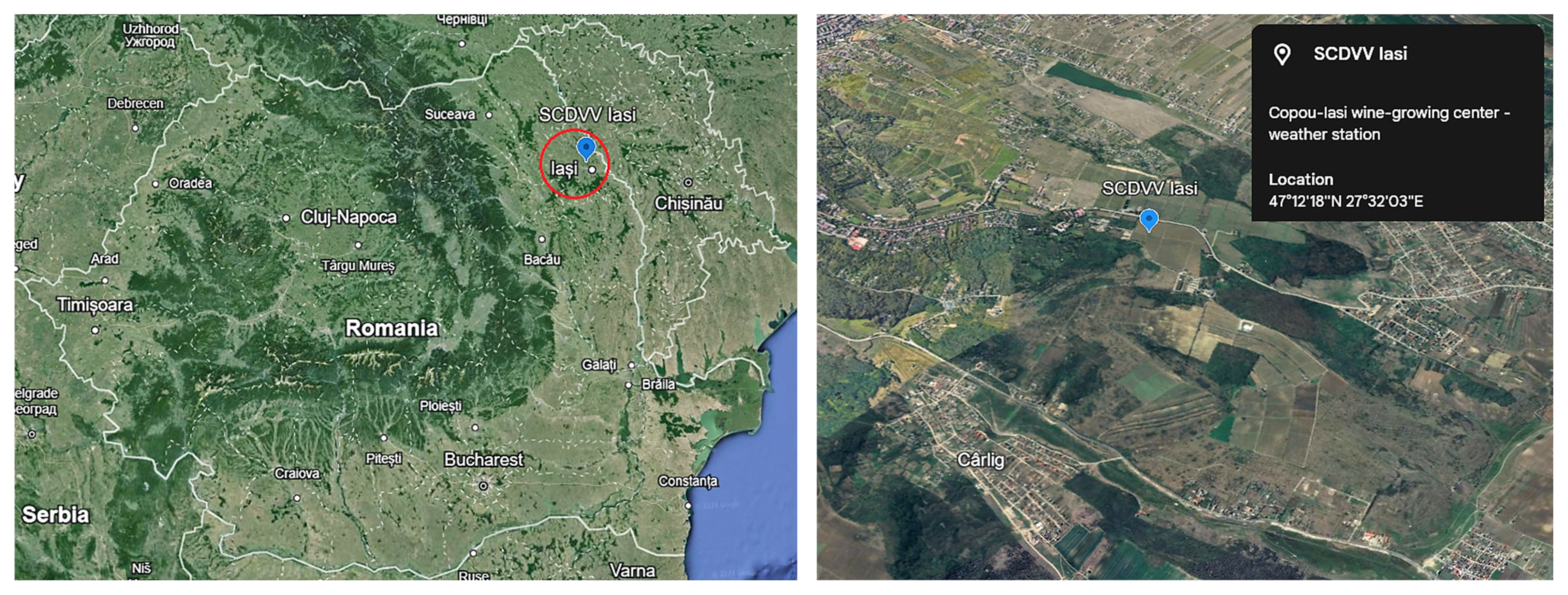
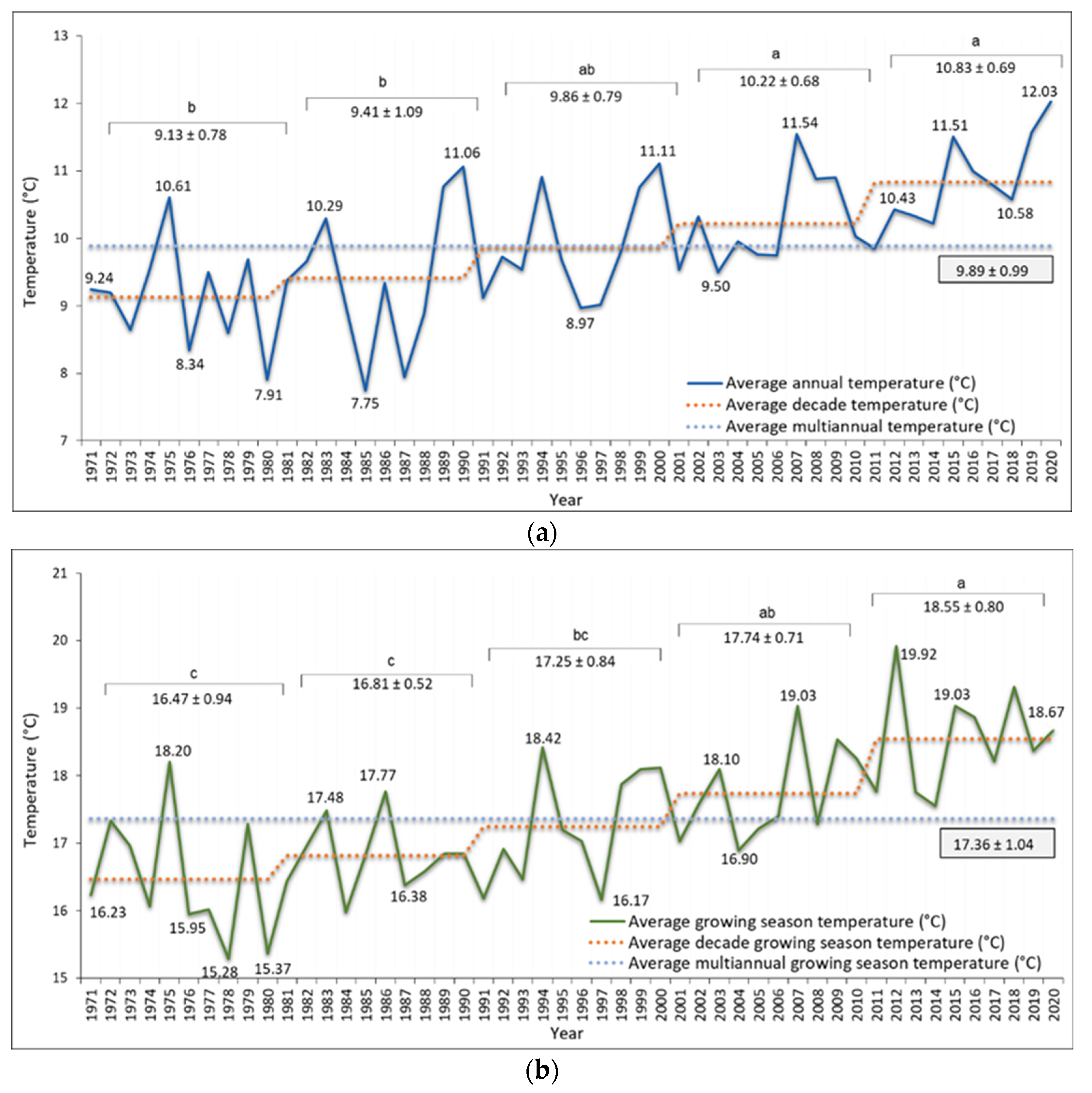
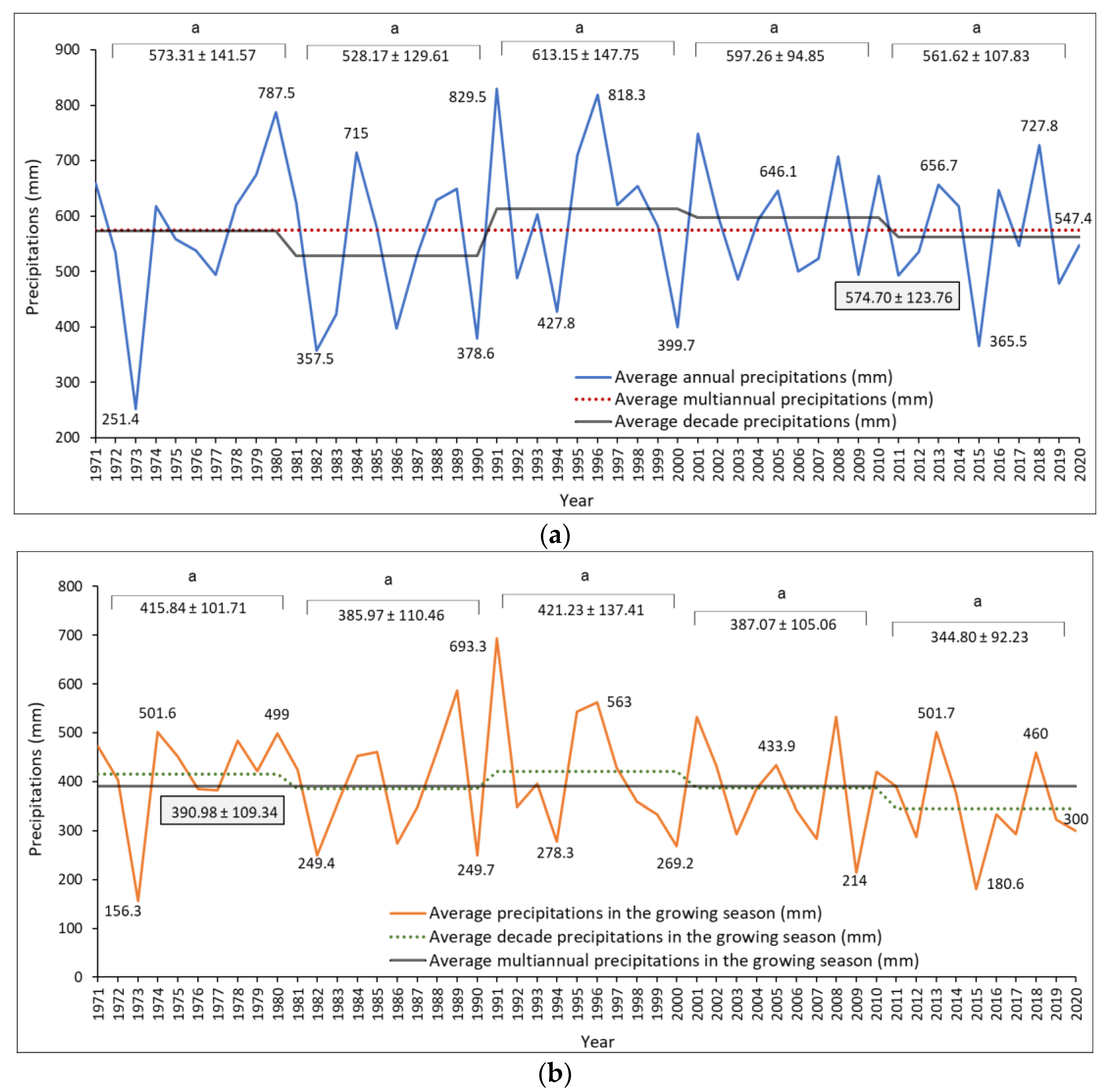
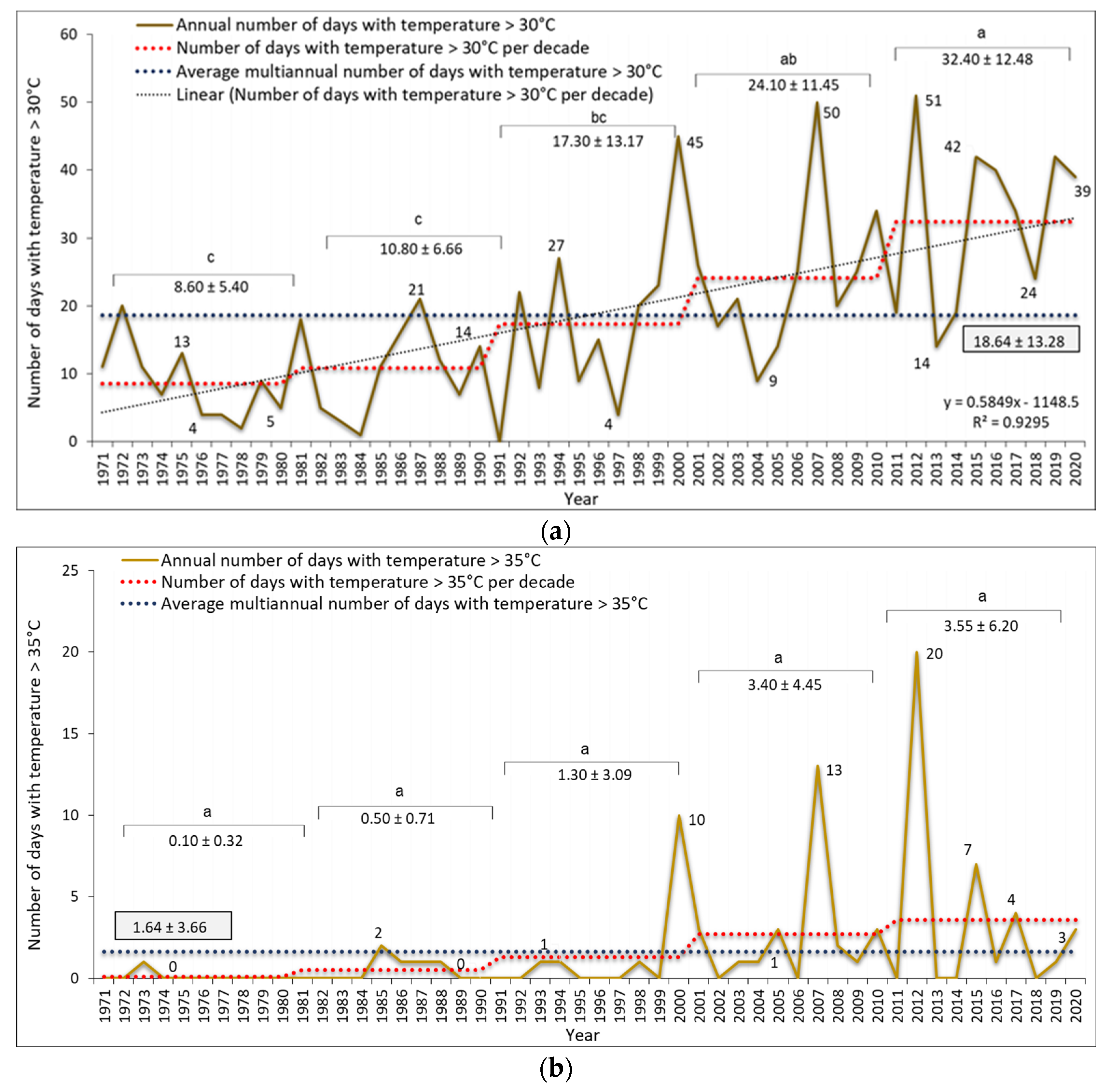
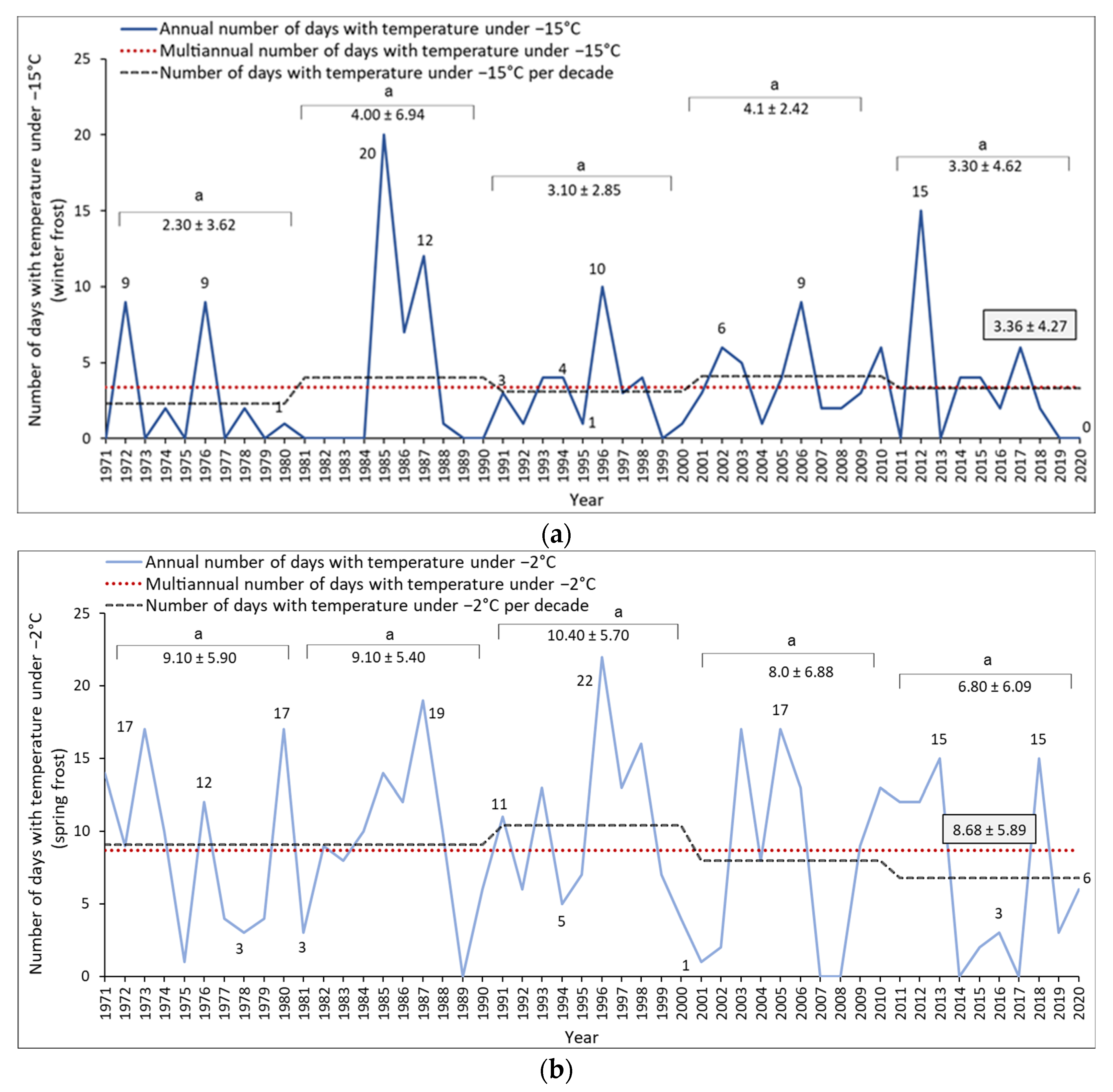
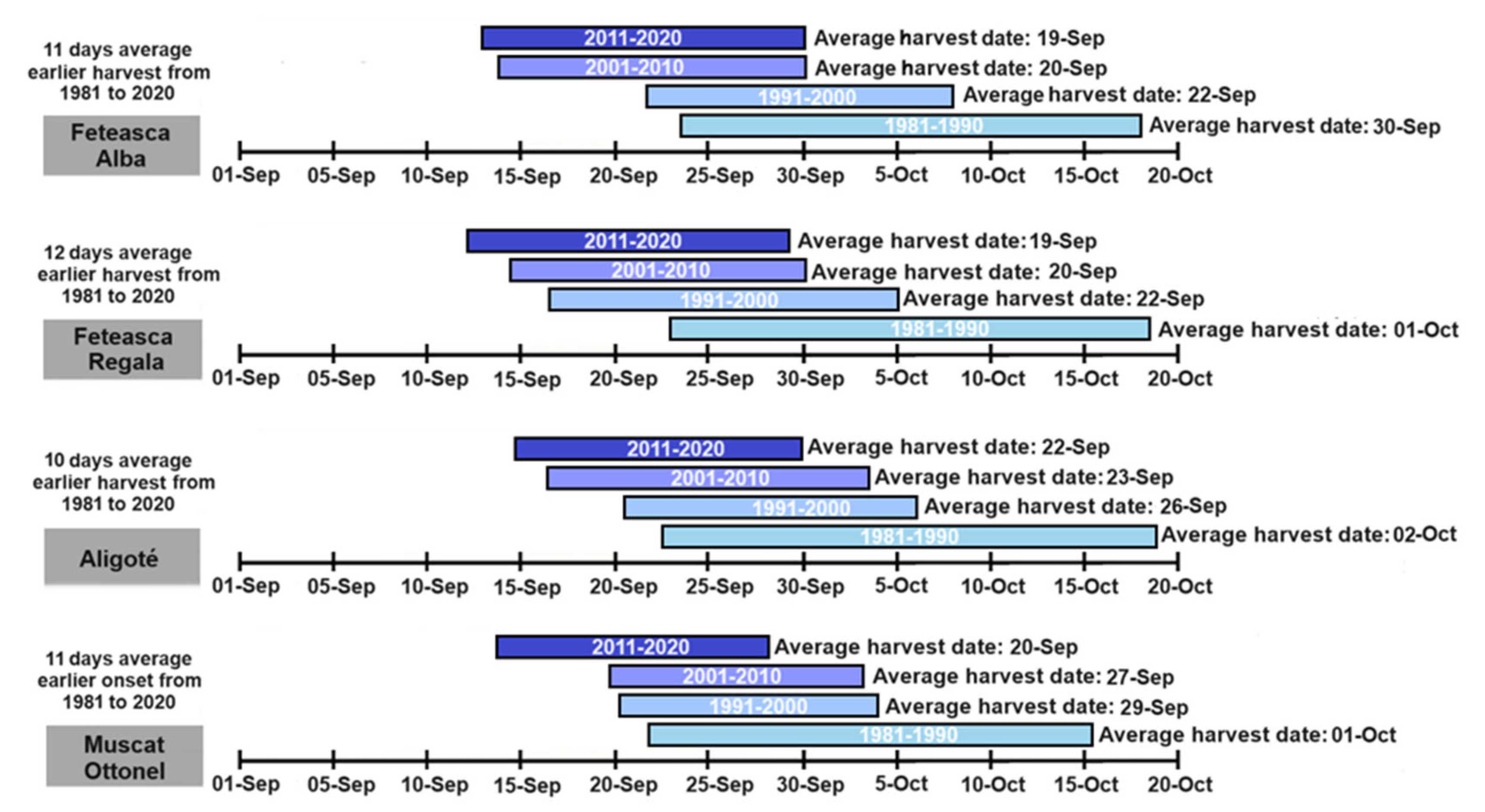
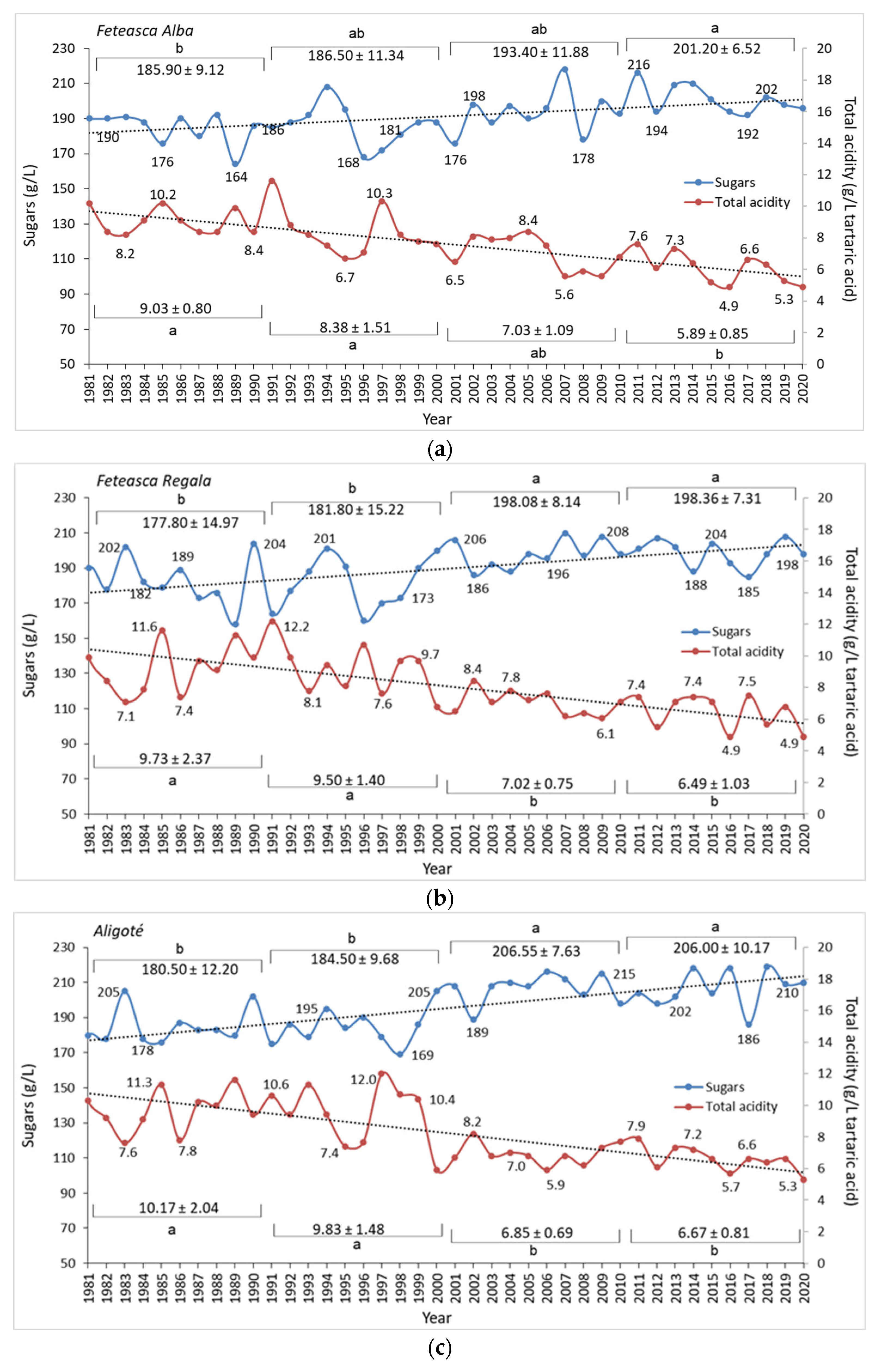
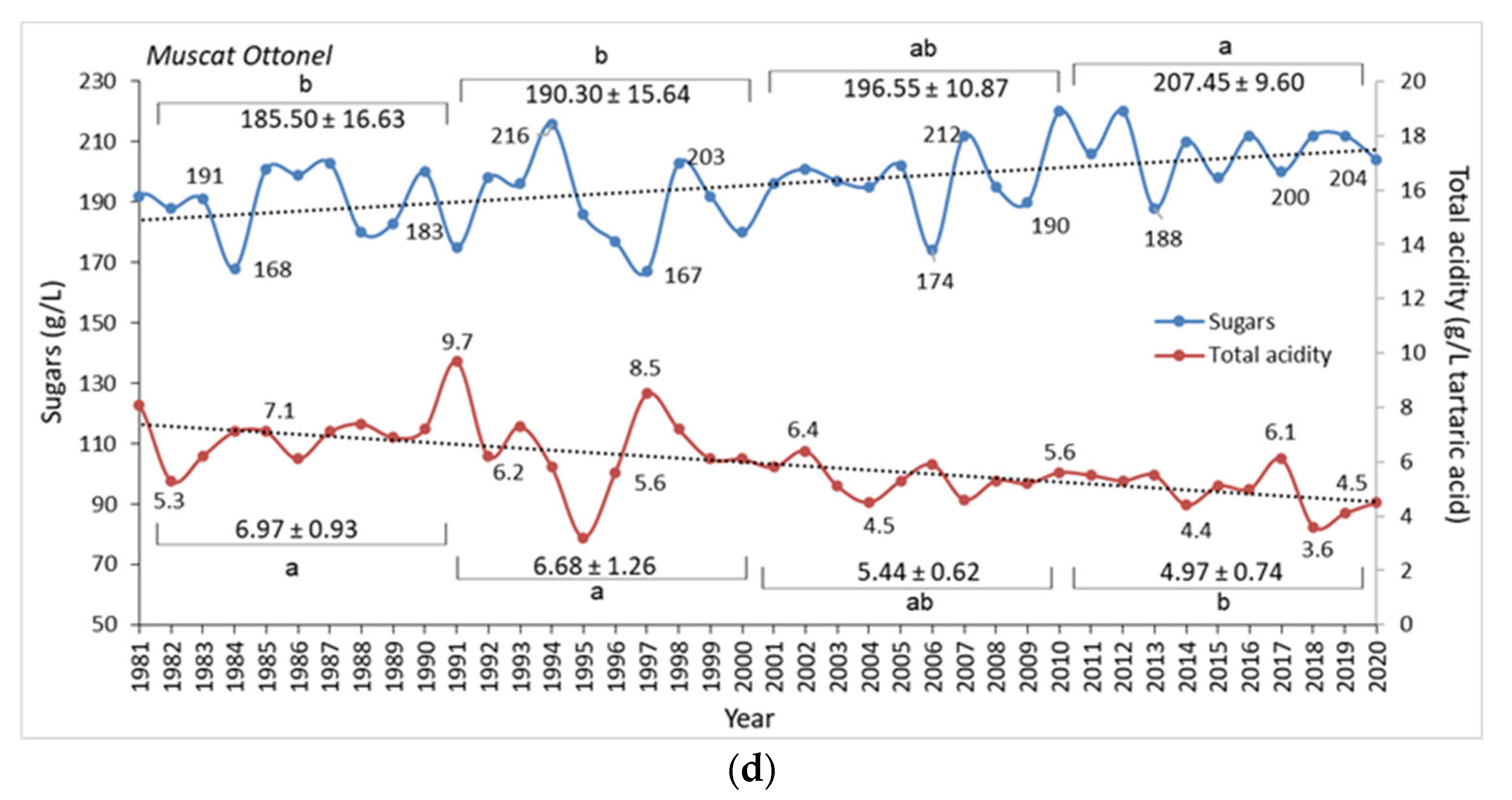
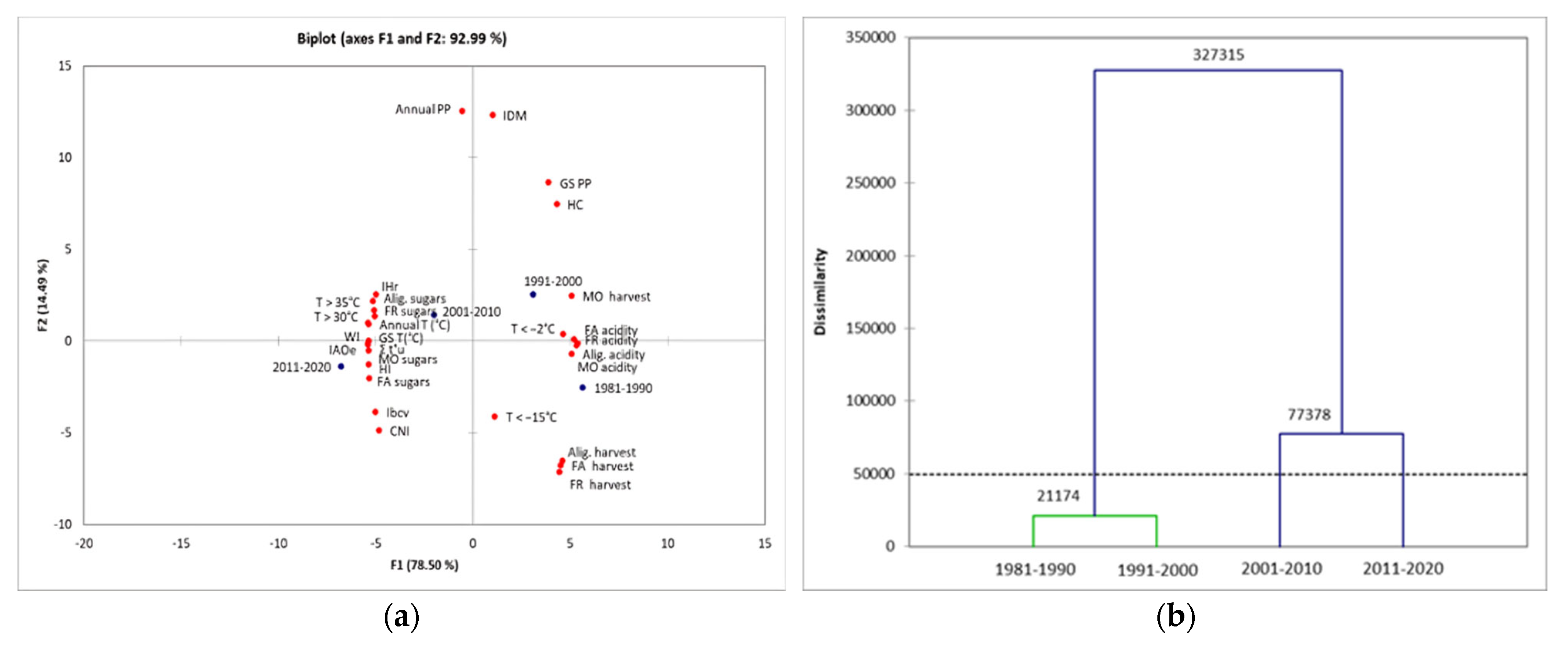
| Bioclimatic Indices | Decades | Average (1971–2020) | |||||
|---|---|---|---|---|---|---|---|
| 1971–1980 | 1981–1990 | 1991–2000 | 2001–2010 | 2011–2020 | |||
| Σt°g (°C) | 3020 ± 172 c | 3083 ± 99 c | 3159 ± 148 bc | 3262 ± 140 ab | 3398 ± 139 a | 3185 ± 191 | |
| Σt°a (°C) | 2864 ± 191 c | 2958 ± 139 c | 3021 ± 191 bc | 3151 ± 130 ab | 3291 ± 168 a | 3057 ± 219 | |
| Σt°u (°C) | 1251 ± 160 c | 1308 ± 87 c | 1379 ± 126 bc | 1469 ± 136 ab | 1609 ± 132 a | 1403 ± 178 | |
| HC | Average | 1.5 ± 0.4 | 1.3 ± 0.4 | 1.4 ± 0.5 | 1.3 ± 0.4 | 1.1 ± 0.3 | 1.3 ± 0.4 |
| Class | Moderate humidity | Moderate humidity | Moderate humidity | Moderate humidity | Insufficient humidity | Moderate humidity | |
| IDM | Average | 30 ± 8 | 27 ± 7 | 31 ± 8 | 30 ± 5 | 27 ± 6 | 29 ± 7 |
| Class | Humid | Semi-humid | Humid | Humid | Semi-humid | Humid | |
| IHr | Average | 1.8 ± 0.3 bc | 1.8 ± 0.3 cd | 2.1 ± 0.3 c | 2.1 ± 0.2 ab | 2.4 ± 0.3 a | 2.1 ± 0.3 |
| Ibcv | Average | 7.0 ± 3.6 | 7.2 ± 2.7 | 7.2 ± 2.6 | 7.7 ± 2.9 | 9.2 ± 3.3 | 7.7 ± 3.0 |
| IAOe | Average | 4152 ± 280 c | 4223 ± 301 c | 4325 ± 399 bc | 4482 ± 266 cb | 4690 ± 252 ab | 4375 ± 352 |
| Class | Unsuitable for red wine production | Unsuitable for red wine production | Medium favorability for red wine | Medium favorability for red wine | Very favorable for red wine | Medium favorability for red wine | |
| HI | Average | 1822 ± 181 c | 1928 ± 130 c | 1976 ± 190 bc | 2098 ± 150 ab | 2268 ± 161 a | 2018 ± 222 |
| Class | HI3—temperate climate | HI3— temperate climate | HI3— temperate climate | HI4— temperate climate | HI4—warm temperate climate | HI3— temperate climate | |
| WI | Average | 1303 ± 159 c | 1374 ± 78 c | 1452 ± 133 bc | 1535 ± 120 ab | 1682 ± 139 a | 1469 ± 181 |
| Class | Ib | Ib | II | II | III | II | |
| CNI | Average | 10.9 ± 1.2 | 10.9 ± 1.3 | 10.8 ± 1.8 | 11.1 ± 0.6 | 12.2 ± 1.2 | 11.2 ± 1.3 |
| Class | Very cold nights | Very cold nights | Very cold nights | Very cold nights | Cold nights | Very cold nights | |
| Parameters | No. Days T > 35 °C | No. Days T > 30 °C | GST (°C) | Annual T (°C) | GS PP (mm) | Annual PP (mm) | FA Sugars | FR Sugars | Al Sugars | MO Sugars | FA Acidity | FR Acidity | Al Acidity | MO Acidity |
|---|---|---|---|---|---|---|---|---|---|---|---|---|---|---|
| FA H-date | −0.6186 | −0.6731 | −0.6825 | −0.6845 | 0.4956 | −0.2119 | ||||||||
| FR H-date | −0.7260 | −0.8280 | −0.8534 | −0.8550 | 0.6604 | −0.1025 | ||||||||
| Al H-date | −0.8395 | −0.9045 | −0.9017 | −0.9026 | 0.7800 | 0.0811 | ||||||||
| MO H-date | −0.7806 | −0.9416 | −0.9833 | −0.9832 | 0.8642 | 0.2408 | ||||||||
| FA sugars | 0.9040 | 0.9815 | 0.9705 | 0.9696 | −0.9660 | −0.4700 | 1 | |||||||
| FR sugars | 0.9802 | 0.9595 | 0.8983 | 0.8977 | −0.9352 | −0.4413 | 0.8977 | 1 | ||||||
| Al sugars | 0.9864 | 0.9562 | 0.8891 | 0.8884 | −0.9420 | −0.4728 | 0.8969 | 0.9993 | 1 | |||||
| MO sugars | 0.8522 | 0.9710 | 0.9856 | 0.9851 | −0.9252 | −0.3622 | 0.9917 | 0.8645 | 0.8595 | 1 | ||||
| FA acidity | −0.9094 | −0.9895 | −0.9854 | −0.9854 | 0.9128 | 0.2782 | −0.9520 | −0.9554 | −0.9473 | −0.9541 | 1 | |||
| FR acidity | −0.9902 | −0.9793 | −0.9199 | −0.9189 | 0.9777 | 0.5237 | −0.9456 | −0.9884 | −0.9904 | −0.9107 | 0.9576 | 1 | ||
| Al acidity | −0.9926 | −0.9649 | −0.8975 | −0.8966 | 0.9609 | 0.5101 | −0.9168 | −0.9962 | −0.9981 | −0.8782 | 0.9484 | 0.9967 | 1 | |
| MO acidity | −0.9720 | −0.9940 | −0.9534 | −0.9527 | 0.9715 | 0.4608 | −0.9646 | −0.9821 | −0.9812 | −0.9416 | 0.9796 | 0.9953 | 0.9877 | 1 |
| Σt°g | 0.8937 | 0.9925 | 0.9967 | 0.9964 | −0.9308 | −0.3255 | 0.9828 | 0.9233 | 0.9168 | 0.9875 | −0.9894 | −0.9471 | −0.9265 | −0.9733 |
| Σt°a | 0.9135 | 0.9967 | 0.9912 | 0.9908 | −0.9482 | −0.3718 | 0.9880 | 0.9346 | 0.9298 | 0.9861 | −0.9877 | −0.9603 | −0.9405 | −0.9820 |
| Σt°u | 0.8789 | 0.9863 | 0.9947 | 0.9943 | −0.9319 | −0.3444 | 0.9900 | 0.9007 | 0.8949 | 0.9961 | −0.9768 | −0.9345 | −0.9086 | −0.9627 |
| HC | −0.9698 | −0.9851 | −0.9384 | −0.9372 | 0.9942 | 0.5578 | −0.9807 | −0.9540 | −0.9569 | −0.9512 | 0.9512 | 0.9878 | 0.9719 | 0.9895 |
| IDM | −0.9649 | −0.9202 | −0.8388 | −0.8368 | 0.9925 | 0.7320 | −0.9326 | −0.9061 | −0.9171 | −0.8783 | 0.8574 | 0.9555 | 0.9393 | 0.9393 |
| IHr | 0.8890 | 0.9879 | 0.9944 | 0.9944 | −0.9068 | −0.2609 | 0.9602 | 0.9354 | 0.9265 | 0.9682 | −0.9978 | −0.9441 | −0.9300 | −0.9712 |
| Ibcv | 0.9269 | 0.9975 | 0.9861 | 0.9858 | −0.9395 | −0.3435 | 0.9705 | 0.9585 | 0.9527 | 0.9666 | −0.9972 | −0.9702 | −0.9579 | −0.9890 |
| IAOe | 0.9176 | 0.9936 | 0.9863 | 0.9862 | −0.9249 | −0.3064 | 0.9605 | 0.9574 | 0.9504 | 0.9601 | −0.9995 | −0.9637 | −0.9532 | −0.9843 |
| HI | 0.9290 | 0.9972 | 0.9820 | 0.9813 | −0.9653 | −0.4270 | 0.9930 | 0.9386 | 0.9360 | 0.9842 | −0.9800 | −0.9692 | −0.9489 | −0.9863 |
| WI | 0.8689 | 0.9844 | 0.9986 | 0.9984 | −0.9169 | −0.3005 | 0.9818 | 0.9004 | 0.8930 | 0.9924 | −0.9822 | −0.9285 | −0.9042 | −0.9593 |
| CNI | 0.7127 | 0.8700 | 0.9130 | 0.8820 | −0.8842 | −0.2936 | 0.9443 | 0.7063 | 0.7050 | 0.9278 | −0.8802 | −0.7946 | −0.7305 | −0.8251 |
Disclaimer/Publisher’s Note: The statements, opinions and data contained in all publications are solely those of the individual author(s) and contributor(s) and not of MDPI and/or the editor(s). MDPI and/or the editor(s) disclaim responsibility for any injury to people or property resulting from any ideas, methods, instructions or products referred to in the content. |
© 2024 by the authors. Licensee MDPI, Basel, Switzerland. This article is an open access article distributed under the terms and conditions of the Creative Commons Attribution (CC BY) license (https://creativecommons.org/licenses/by/4.0/).
Share and Cite
Filimon, R.M.; Bunea, C.I.; Filimon, R.V.; Bora, F.D.; Damian, D. Long-Term Evolution of the Climatic Factors and Its Influence on Grape Quality in Northeastern Romania. Horticulturae 2024, 10, 705. https://doi.org/10.3390/horticulturae10070705
Filimon RM, Bunea CI, Filimon RV, Bora FD, Damian D. Long-Term Evolution of the Climatic Factors and Its Influence on Grape Quality in Northeastern Romania. Horticulturae. 2024; 10(7):705. https://doi.org/10.3390/horticulturae10070705
Chicago/Turabian StyleFilimon, Roxana Mihaela, Claudiu Ioan Bunea, Răzvan Vasile Filimon, Florin Dumitru Bora, and Doina Damian. 2024. "Long-Term Evolution of the Climatic Factors and Its Influence on Grape Quality in Northeastern Romania" Horticulturae 10, no. 7: 705. https://doi.org/10.3390/horticulturae10070705






